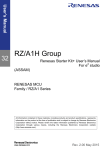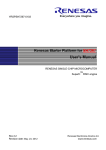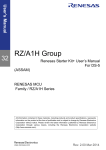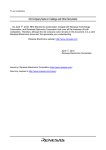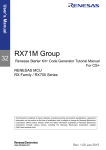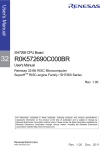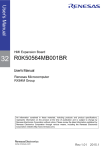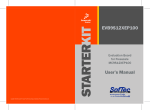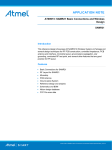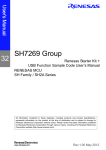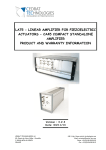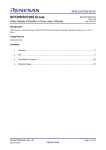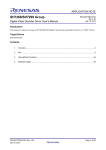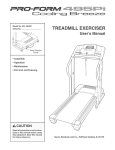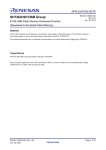Download Renesas Starter Kit+ for SH7269 User`s Manual
Transcript
32 SH7269 Group Renesas Starter Kit User’s Manual RENESAS MCU SH Family / SH2A Series All information contained in these materials, including products and product specifications, represents information on the product at the time of publication and is subject to change by Renesas Electronics Corporation without notice. Please review the latest information published by Renesas Electronics Corporation through various means, including the Renesas Electronics Corporation website (http://www.renesas.com). Rev.1.00 May 2012 Notice 1. 2. 3. 4. 5. 6. 7. All information included in this document is current as of the date this document is issued. Such information, however, is subject to change without any prior notice. Before purchasing or using any Renesas Electronics products listed herein, please confirm the latest product information with a Renesas Electronics sales office. Also, please pay regular and careful attention to additional and different information to be disclosed by Renesas Electronics such as that disclosed through our website. Renesas Electronics does not assume any liability for infringement of patents, copyrights, or other intellectual property rights of third parties by or arising from the use of Renesas Electronics products or technical information described in this document. No license, express, implied or otherwise, is granted hereby under any patents, copyrights or other intellectual property rights of Renesas Electronics or others. You should not alter, modify, copy, or otherwise misappropriate any Renesas Electronics product, whether in whole or in part. Descriptions of circuits, software and other related information in this document are provided only to illustrate the operation of semiconductor products and application examples. You are fully responsible for the incorporation of these circuits, software, and information in the design of your equipment. Renesas Electronics assumes no responsibility for any losses incurred by you or third parties arising from the use of these circuits, software, or information. When exporting the products or technology described in this document, you should comply with the applicable export control laws and regulations and follow the procedures required by such laws and regulations. You should not use Renesas Electronics products or the technology described in this document for any purpose relating to military applications or use by the military, including but not limited to the development of weapons of mass destruction. Renesas Electronics products and technology may not be used for or incorporated into any products or systems whose manufacture, use, or sale is prohibited under any applicable domestic or foreign laws or regulations. Renesas Electronics has used reasonable care in preparing the information included in this document, but Renesas Electronics does not warrant that such information is error free. Renesas Electronics assumes no liability whatsoever for any damages incurred by you resulting from errors in or omissions from the information included herein. Renesas Electronics products are classified according to the following three quality grades: “Standard”, “High Quality”, and “Specific”. The recommended applications for each Renesas Electronics product depends on the product’s quality grade, as indicated below. You must check the quality grade of each Renesas Electronics product before using it in a particular application. You may not use any Renesas Electronics product for any application categorized as “Specific” without the prior written consent of Renesas Electronics. Further, you may not use any Renesas Electronics product for any application for which it is not intended without the prior written consent of Renesas Electronics. Renesas Electronics shall not be in any way liable for any damages or losses incurred by you or third parties arising from the use of any Renesas Electronics product for an application categorized as “Specific” or for which the product is not intended where you have failed to obtain the prior written consent of Renesas Electronics. The quality grade of each Renesas Electronics product is “Standard” unless otherwise expressly specified in a Renesas Electronics data sheets or data books, etc. “Standard”: Computers; office equipment; communications equipment; test and measurement equipment; audio and visual equipment; home electronic appliances; machine tools; personal electronic equipment; and industrial robots. “High Quality”: Transportation equipment (automobiles, trains, ships, etc.); traffic control systems; anti-disaster systems; anticrime systems; safety equipment; and medical equipment not specifically designed for life support. “Specific”: Aircraft; aerospace equipment; submersible repeaters; nuclear reactor control systems; medical equipment or systems for life support (e.g. artificial life support devices or systems), surgical implantations, or healthcare intervention (e.g. excision, etc.), and any other applications or purposes that pose a direct threat to human life. 8. You should use the Renesas Electronics products described in this document within the range specified by Renesas Electronics, especially with respect to the maximum rating, operating supply voltage range, movement power voltage range, heat radiation characteristics, installation and other product characteristics. Renesas Electronics shall have no liability for malfunctions or damages arising out of the use of Renesas Electronics products beyond such specified ranges. 9. Although Renesas Electronics endeavors to improve the quality and reliability of its products, semiconductor products have specific characteristics such as the occurrence of failure at a certain rate and malfunctions under certain use conditions. Further, Renesas Electronics products are not subject to radiation resistance design. Please be sure to implement safety measures to guard them against the possibility of physical injury, and injury or damage caused by fire in the event of the failure of a Renesas Electronics product, such as safety design for hardware and software including but not limited to redundancy, fire control and malfunction prevention, appropriate treatment for aging degradation or any other appropriate measures. Because the evaluation of microcomputer software alone is very difficult, please evaluate the safety of the final products or system manufactured by you. 10. Please contact a Renesas Electronics sales office for details as to environmental matters such as the environmental compatibility of each Renesas Electronics product. Please use Renesas Electronics products in compliance with all applicable laws and regulations that regulate the inclusion or use of controlled substances, including without limitation, the EU RoHS Directive. Renesas Electronics assumes no liability for damages or losses occurring as a result of your noncompliance with applicable laws and regulations. 11. This document may not be reproduced or duplicated, in any form, in whole or in part, without prior written consent of Renesas Electronics. 12. Please contact a Renesas Electronics sales office if you have any questions regarding the information contained in this document or Renesas Electronics products, or if you have any other inquiries. (Note 1) “Renesas Electronics” as used in this document means Renesas Electronics Corporation and also includes its majorityowned subsidiaries. (Note 2) “Renesas Electronics product(s)” means any product developed or manufactured by or for Renesas Electronics. Disclaimer By using this Renesas Starter Kit (RSK), the user accepts the following terms: The RSK is not guaranteed to be error free, and the entire risk as to the results and performance of the RSK is assumed by the User. The RSK is provided by Renesas on an “as is” basis without warranty of any kind whether express or implied, including but not limited to the implied warranties of satisfactory quality, fitness for a particular purpose, title and non-infringement of intellectual property rights with regard to the RSK. Renesas expressly disclaims all such warranties. Renesas or its affiliates shall in no event be liable for any loss of profit, loss of data, loss of contract, loss of business, damage to reputation or goodwill, any economic loss, any reprogramming or recall costs (whether the foregoing losses are direct or indirect) nor shall Renesas or its affiliates be liable for any other direct or indirect special, incidental or consequential damages arising out of or in relation to the use of this RSK, even if Renesas or its affiliates have been advised of the possibility of such damages. Precautions The following precautions should be observed when operating any RSK product: This Renesas Starter Kit is only intended for use in a laboratory environment under ambient temperature and humidity conditions. A safe separation distance should be used between this and any sensitive equipment. Its use outside the laboratory, classroom, study area or similar such area invalidates conformity with the protection requirements of the Electromagnetic Compatibility Directive and could lead to prosecution. The product generates, uses, and can radiate radio frequency energy and may cause harmful interference to radio communications. However, there is no guarantee that interference will not occur in a particular installation. If this equipment causes harmful interference to radio or television reception, which can be determined by turning the equipment off or on, you are encouraged to try to correct the interference by one or more of the following measures; • ensure attached cables do not lie across the equipment • reorient the receiving antenna • increase the distance between the equipment and the receiver • connect the equipment into an outlet on a circuit different from that which the receiver is connected • power down the equipment when not in use • consult the dealer or an experienced radio/TV technician for help NOTE: It is recommended that wherever possible shielded interface cables are used. The product is potentially susceptible to certain EMC phenomena. To mitigate against them it is recommended that the following measures be undertaken; • The user is advised that mobile phones should not be used within 10m of the product when in use. • The user is advised to take ESD precautions when handling the equipment. The Renesas Starter Kit does not represent an ideal reference design for an end product and does not fulfil the regulatory standards for an end product. How to Use This Manual 1. Purpose and Target Readers This manual is designed to provide the user with an understanding of the RSK hardware functionality, and electrical characteristics. It is intended for users designing sample code on the RSK platform, using the many different incorporated peripheral devices. The manual comprises of an overview of the capabilities of the RSK product, but does not intend to be a guide to embedded programming or hardware design. Further details regarding setting up the RSK and development environment can found in the tutorial manual. Particular attention should be paid to the precautionary notes when using the manual. These notes occur within the body of the text, at the end of each section, and in the Usage Notes section. The revision history summarizes the locations of revisions and additions. It does not list all revisions. Refer to the text of the manual for details. The following documents apply to the SH7269 Group. Make sure to refer to the latest versions of these documents. The newest versions of the documents listed may be obtained from the Renesas Electronics Web site. Document Type Description Document Title User’s Manual Describes the technical details of the RSK hardware. RSKSH7269 Manual Tutorial Manual Provides a guide to setting up RSK environment, running sample code and debugging programs. RSKSH7269 Tutorial Manual Quick Start Guide Provides simple instructions to setup the RSK and run the first sample, on a single A4 sheet. RSKSH7269 Quick Start Guide USB Manual Provides sample instructions to configure the RSK and Host PC for running the USB function sample code. RSKSH7269 USB Function Manual Schematics Full detail circuit schematics of the RSK. RSKSH7269 Schematics Hardware Manual Provides technical microcontroller. Function details of the SH7269 User SH7269 Group Hardware Manual Document No. 2. List of Abbreviations and Acronyms Abbreviation Full Form ADC Analogue-to-Digital Converter bps CAN bits per second Controller-Area Network CPU CRC Central Processing Unit Cyclic Redundancy Check DIP DMA Dual In-line Package Direct Memory Access DMAC E10A Direct Memory Access Controller On-chip Debugger EEPROM EMC Electronically Erasable Programmable Read Only Memory Electromagnetic Compatibility ESD HEW Electrostatic Discharge High-performance Embedded Workshop IIC IRQ Phillips™ Inter-Integrated Circuit Connection Bus Interrupt Request LCD LED Liquid Crystal Display Light Emitting Diode MCU MTU Micro-controller Unit Multifunction Timer Unit NMI PC Non Maskable Interrupt Program Counter PWM RSK Pulse Width Modulation Renesas Starter Kit RSPI SDRAM Renesas Serial Peripheral Interface Synchronous Dynamic Random Access Memory SFR SPI Special Function Register Serial Peripheral Interface SRAM UART Static Random Access Memory Universal Asynchronous Receiver/Transmitter Table of Contents 1. Overview ............................................................................................................................................ 7 1.1 1.2 Purpose...................................................................................................................................................................... 7 Features ..................................................................................................................................................................... 7 2. Power Supply ..................................................................................................................................... 8 2.1 2.2 Requirements ............................................................................................................................................................ 8 Power-Up Behaviour................................................................................................................................................. 8 3. Board Layout ..................................................................................................................................... 9 3.1 3.2 3.3 Component Layout.................................................................................................................................................... 9 Board Dimensions ................................................................................................................................................... 10 Component Placement .............................................................................................................................................11 4. Connectivity ..................................................................................................................................... 13 4.1 4.2 Internal RSK Connections ...................................................................................................................................... 13 Debugger Connections ............................................................................................................................................ 14 5. User Circuitry................................................................................................................................... 15 5.1 5.2 5.3 5.4 5.5 5.6 5.7 5.8 5.9 Reset Circuit............................................................................................................................................................ 15 Clock Circuit ........................................................................................................................................................... 15 Switches .................................................................................................................................................................. 15 LEDs ....................................................................................................................................................................... 15 Potentiometer .......................................................................................................................................................... 16 Debug LCD Module ............................................................................................................................................... 16 RS232 Serial Port.................................................................................................................................................... 16 USB ......................................................................................................................................................................... 17 CAN ........................................................................................................................................................................ 18 6. Configuration ................................................................................................................................... 19 6.1 6.2 6.3 6.4 6.5 6.6 6.7 6.8 6.9 6.10 6.11 6.12 6.13 Modifying the RSK ................................................................................................................................................. 19 MCU Operating Modes ........................................................................................................................................... 19 E10A Debugger Interface........................................................................................................................................ 20 USB Configuration ................................................................................................................................................. 20 ADC Configuration ................................................................................................................................................. 21 RS232 Serial Port Configuration ............................................................................................................................ 22 External Bus Configuration .................................................................................................................................... 23 IIC Pin Configuration ............................................................................................................................................. 25 SPI Pin Configuration ............................................................................................................................................. 26 SPDIF Pin Configuration ........................................................................................................................................ 26 Audio CODEC Pin Configuration .......................................................................................................................... 27 Ethernet Pin Configuration ..................................................................................................................................... 28 SD/MMC Pin Configuration ................................................................................................................................... 29 7. Headers ............................................................................................................................................ 31 7.1 Application Headers ................................................................................................................................................ 31 8. Code Development........................................................................................................................... 35 8.1 8.2 8.3 Overview ................................................................................................................................................................. 35 Compiler Restrictions ............................................................................................................................................. 35 Debugging Support ................................................................................................................................................. 35 9. Additional Information..................................................................................................................... 36 RSKSH7269 RENESAS STARTER KIT R20UT0592EG0100 Rev.1.00 May 23, 2012 1. Overview 1.1 Purpose This RSK is an evaluation tool for Renesas microcontrollers. This manual describes the technical details of the RSK hardware. The Quick Start Guide and Tutorial Manual provide details of the software installation and debugging environment. 1.2 Features This RSK provides an evaluation of the following features: • Renesas microcontroller programming • User code debugging • User circuitry such as switches, LEDs and a potentiometer • Sample application • Sample peripheral device initialisation code The RSK board contains all the circuitry required for microcontroller operation. R20UT0592EG0100 Rev. 1.00 May 23, 2012 Page 7 of 40 RSKSH7269 2. Power Supply 2. Power Supply 2.1 Requirements This RSK is supplied with an E10A debugger. The debugger is able to power the RSK board with up to 200mA. When the RSK is connected to another system then that system should supply power to the RSK. All RSK and RSK+ boards have an optional centre positive supply connector using a 2.0mm barrel power jack. Details of the external power supply requirements for the RSK, and connections are shown in Table 2-1 below. Connector PWR Supply Voltages Regulated, 5V DC or 7-15V DC CAUTION: There is no Over Voltage protection Always confirm the Power supply settings before applying power Table 2-1: Main Power Supply Requirements In order for the debug LCD to operate, the following jumper settings must be made for the different power supply options: Jumper RSK Powered by External 5V Supply RSK Powered by External 7 to 15V Supply J16 Jumper across pins 1 and 2. Open pins 1 and 2. J17 Jumper across pins 1 and 2. Open pins 1 and 2 Table 2-2: LCD Power Supply Options The main power supply connected to PWR should supply a minimum of 10W to ensure full functionality. 2.2 Power-Up Behaviour When the RSK is purchased, the RSK board has the ‘Release’ or stand-alone code from the example tutorial code pre-programmed into the Renesas microcontroller. On powering up the board the user LEDs will start to flash. After 200 flashes or after pressing any switch, the LEDs will flash at a rate controlled by the potentiometer. R20UT0592EG0100 Rev. 1.00 May 23, 2012 Page 8 of 40 RSKSH7269 3. Board Layout 3. Board Layout 3.1 Component Layout Figure 3-1 below shows the top component layout of the board. Reset Switch USB Host USB Function CAN 2 CAN 1 E10A Header Video In 1 Video In 2 Audio Out Audio In TFT Screen QVGA Volt Select Power In User LEDS Volt Select Ethernet Serial 2 Line Character Display Option Switches User Potentiometer User Switch 3 User Switch 2 User Switch 1 Figure 3-1: Board Layout R20UT0592EG0100 Rev. 1.00 May 23, 2012 Page 9 of 40 RSKSH7269 3.2 3. Board Layout Board Dimensions Figure 3-2 below gives the board dimensions and connector positions. All the through-hole connectors are on a common 0.1 inch grid for easy interfacing. Figure 3-2: Board Dimensions R20UT0592EG0100 Rev. 1.00 May 23, 2012 Page 10 of 40 RSKSH7269 3.3 3. Board Layout Component Placement Figure 3-3 below shows placement of individual components on the top-side PCB. Component types and values can be looked up using the board schematics. Figure 3-3: Top-Side Component Placement R20UT0592EG0100 Rev. 1.00 May 23, 2012 Page 11 of 40 RSKSH7269 3. Board Layout Figure 3-4 below shows placement of individual components on the bottom-side PCB. Component types and values can be looked up using the board schematics. Figure 3-4: Bottom-Side Component Placement R20UT0592EG0100 Rev. 1.00 May 23, 2012 Page 12 of 40 RSKSH7269 4. Connectivity 4. Connectivity 4.1 Internal RSK Connections The diagram below shows the RSK board components and their connectivity to the MCU. Low Voltage Supply Mode Application Board Headers MCU Current Draw Test Point Power Jack VCC QVGA TFT Screen VDC 4 MCU Ring Headers Debug LCD E1 Debug Interface SH7269 CPU Reset IRQ RS-232 Serial Port USB Function ADC I/O SW3 CAN SW2 Potentiometer SW1 RESET Switches Ethernet Power User LEDs G O R R G Audio Codec Figure 4-1: Internal RSK Block Diagram R20UT0592EG0100 Rev. 1.00 May 23, 2012 Page 13 of 40 RSKSH7269 4.2 4. Connectivity Debugger Connections The diagram below shows the connections between the RSK, E10A debugger and the host PC. User Interface Cable USB Cable E10A RSK Host PC Figure 4-2: Debugger Connection Diagram R20UT0592EG0100 Rev. 1.00 May 23, 2012 Page 14 of 40 RSKSH7269 5. User Circuitry 5. User Circuitry 5.1 Reset Circuit A reset control circuit is fitted to the RSK. Resets are handled by this external device ensuring that the CPU receives a valid reset signal. The external Reset switch connect to this device. 5.2 Clock Circuit A clock circuit is fitted to the RSK to generate the required clock signal to drive the MCU, and associated peripherals. Refer to the SH7269 hardware manual for details regarding the clock signal requirements, and the RSKSH7269 board schematics for information regarding the clock circuitry in use on the RSK. Details of the oscillators fitted to the RSK are listed in Table 5-1 below. Crystal Function Default Placement Frequency Device Package X2 Real time Clock Fitted 32.768kHz Encapsulated, SMT X3 Audio Codec Clock Fitted 18.432MHz Encapsulated, SMT X4 CPU Video Clock Fitted 27MHz Encapsulated, SMT X5 LAN Controller Clock Fitted 25MHz Encapsulated, SMT X6 USB Clock Fitted 48MHz Encapsulated, SMT X7 CPU Audio Clock Fitted 24.576MHz Encapsulated, SMT X8 Main MCU crystal. Fitted 12MHz HC49, SMT Table 5-1: Oscillators 5.3 Switches There are four switches located on the RSK board. The function of each switch and its connection is shown in Table 5-2. User switches are connected to a IIC port expander. This allows for additional ports to be connected to a microcontroller. The switches are connected to this only due to the large number of peripherals of the CPU that have been connected to demonstration circuitry on the board. It is possible for the CPU to receive an on interrupt when any of the switches are pressed by configuring PINT6 (Port H6 Pin 125). When the interrupt is generated the users code will need to poll the port expander to discover which switch caused the interrupt. For further information regarding switch connectivity, refer to the RSKSH7269 board schematics. Switch Function MCU Connection RES When pressed, the microcontroller is reset. U26, Pin 5 SW1 Connects to IIC port expander U18 I/O0 input. An interrupt on PINT6 is possible SCL2 / SDA2 SW2 Connects to IIC port expander U18 I/O1 input. An interrupt on PINT6 is possible SCL2 / SDA2 SW3 Connects to IIC port expander U18 I/O2 input. An interrupt on PINT6 is possible SCL2 / SDA2 Table 5-2: Switch Connections 5.4 LEDs R20UT0592EG0100 Rev. 1.00 May 23, 2012 Page 15 of 40 RSKSH7269 5. User Circuitry There are five LEDs on the RSK board. The function of each LED, its colour, and its connections are shown in Table 5-3. The User LEDs are connected to a IIC port expander. This allows for additional ports to be connected to a microcontroller. The LEDs are connected to this only due to the large number of peripherals of the CPU that have been connected to demonstration circuitry on the board. LED Colour Function MCU Connection 5V_LED Red Indicates the power status No connection 3V3_LED Red Indicates the power status No connection LED0 Green User operated LED. SCL2 / SDA2 LED1 Orange User operated LED. SCL2 / SDA2 LED2 Red User operated LED. SCL2 / SDA2 LED3 Red User operated LED. SCL2 / SDA2 Table 5-3: LED Connections 5.5 Potentiometer A single-turn potentiometer is connected as a potential divider to analogue input AN0, pin 118. The potentiometer can be used to create a voltage between A3V3 and ground (A3V3 is connected to an independent linear regulator). The potentiometer is fitted to offer an easy method of supplying a variable analogue input to the microcontroller. It does not necessarily reflect the accuracy of the controller’s ADC. Refer to the device hardware manual for further details. 5.6 Debug LCD Module A debug LCD module is supplied with the RSK, and should be connected to the LCD header. Care should be taken when installing the LCD module to ensure pins are not bent or damaged. The LCD module is vulnerable to electrostatic discharge (ESD); therefore appropriate ESD protection should be used. The debug LCD module uses a 4-bit interface to reduce pin allocation. No contrast control is provided, as this is set by a resistor supplied on the display module. Connection information for the debug LCD module is provided in Table 5-4 below. Debug LCD Header Pin Circuit Net Name MCU Pin Pin Circuit Net Name 1 Ground - 2 Board_5V 3 No Connection - 4 DLCDRS MCU Pin PJ12 (P220) 5 R/W (pulled to ground) - 6 DLCDE (pulled to ground) PJ11 (P219) 7 No Connection - 8 No Connection - 9 No Connection - 10 No Connection - 11 D12_DLCD4 PJ8 (P178) 12 D13_DLCD5 PJ9 (P179) 13 D14_DLCD6 PG18 (P180) 14 D15_DLCD7 PG19 (P181) Table 5-4: LCD Header Connections 5.7 RS232 Serial Port Connections between the RS232 header and the microcontroller are listed in Table 5-5 below. R20UT0592EG0100 Rev. 1.00 May 23, 2012 Page 16 of 40 RSKSH7269 5. User Circuitry SCI Signal Function MCU Connection TXD7 SCI7 Transmit Signal. PJ15, pin 18 RXD7 SCI7 Receive Signal. PE7, pin 77 CTS7 SCI7 Clear to send. PJ27, pin 239 RTS7 SCI7 Ready to send. PJ28, pin 66 RS232TX External SCI Transmit Signal. N/A RS232RX External SCI Receive Signal. N/A Table 5-5: Serial Port Connections * This connection is a not available in the default RSK configuration - refer to §6 for the required modifications. 5.8 USB Connections between the USB connector and the microcontroller are listed in Table 5-6 below. The SH7269 device supports both USB Host and USB Function. The selection of the peripheral support is possible using the user option switches on the board. A high speed switch (U46) is used to swap the USB signals between the two connectors. The USB Host requires a switched power supply and this is provided by U9. An indication of an overcurrent condition with a connected peripheral can be detected on PINT7. The USB Function requires VBUS detection signal connection to the peripheral which is provided by a level translation FET. To select between USB Host or Function the port expander U19 is used to control the USB connector in use. USB Signal Function MCU Connection USB Connection USBDPOS USB Data+ DP, Pin 94 3 USBDNEG USB Data- DM, 93 2 VBUSH_VBUSD USB VBUS P16, pin 30 1 USBPCON USB Host Power Control PJ31, pin 69 VBUS PINT7 Overcurrent Detection PH7, pin 127 U9 – Power USBSEL Host or Function Selection SCL2 / SDA2* N/A Table 5-6: USB Connections * This connection is a not available directly and is controlled via IIC. R20UT0592EG0100 Rev. 1.00 May 23, 2012 Page 17 of 40 RSKSH7269 5.9 5. User Circuitry CAN Connections between the CAN ICs (U3 and U25) and the microcontroller are listed in Table 5-7 below. The connection for the CAN enable has been connected to U19 which is a IIC controlled port expander. CAN Signal Function MCU Connection CAN IC Connection CTX1 CAN Transmit PJ23, pin 44 U3 pin 1 CRX1 CAN Receive PJ22, pin 43 U3 pin 4 CANEN1 CAN Device Enable SCL2 / SDA2 * U3 pin 8 CTX2 CAN Transmit PJ21, pin 42 U25 pin 1 CRX2 CAN Receive PJ20, pin 38 U25 pin 4 CANEN2 CAN Device Enable SCL2 / SDA2 * U25 pin8 Table 5-7: CAN Connections * This connection is a not available directly and is controlled via IIC. R20UT0592EG0100 Rev. 1.00 May 23, 2012 Page 18 of 40 RSKSH7269 6. Configuration 6. Configuration 6.1 Modifying the RSK This section lists the option links that are used to modify the way RSK operates in order to access different configurations. Configurations are made by modifying link resistors or headers with movable jumpers or by configuration DIP switches A link resistor is a 0Ω surface mount resistor, which is used to short or isolate parts of a circuit. Option links are listed in the following sections, detailing their function when fitted or removed. Bold, blue text indicates the default configuration that the RSK is supplied with. Refer to the component placement diagram (§3) to locate the option links, jumpers and DIP switches. When removing soldered components, always ensure that the RSK is not exposed to a soldering iron for intervals greater than 5 seconds. This is to avoid damage to nearby components mounted on the RSK. When modifying a link resistor, always check the related option links to ensure there is no possible signal contention or short circuits. Because some of the MCU’s pins are multiplexed, some of the peripherals must be used exclusively. Refer to the SH7269 hardware manual and RSKSH7269 board schematics for further information. 6.2 MCU Operating Modes Only ever change the MCU operating mode whilst the RSK is in reset, or turned off; otherwise the MCU may be damaged as a result. Table 6-1 below details the function of the jumpers associated with the MCU boot configuration modes. Reference Position One Position Two Position Three Position Four SW5 ON Disables SSCG NOR Boot Enables NAND Write Protection Enables Flash Protection NOR Write SW5 OFF Enables SSCG QSPI Boot Disables NAND Write Protection Disables NOR Flash Write Protection Table 6-1: MCU Operating Mode Configuration Table 6-2 below details the function of the jumpers associated with the MCU boot configuration modes. Reference SW4 ON SW4 OFF Position One Position Two Enabled A15 to A22 Address Bus Enabled D0 to D15 Data Bus Enabled Board Screen on TFT SDRAM = 16MB Enabled Flash Enabled Flash Enabled external HDMI connector SDRAM = 32MB QSPI NAND Position Three Position Four QSPI = 6 Wire QSPI = 4 wire Table 6-2: MCU Operating Mode Configuration R20UT0592EG0100 Rev. 1.00 May 23, 2012 Page 19 of 40 RSKSH7269 6.3 6. Configuration E10A Debugger Interface Table 6-3 below details the function of the option links associated with the E10A debugger interface configuration. Reference R427 Link Fitted Configuration Advanced User Debugger connected to User interface. Cautions Clock When not fitted the E10A will support Standard Debugging mode. This connection is shared with DMARequest 0 and RSPCK1 Related Ref. R474, R476 Table 6-3: E10A Debugger Interface Option Links 6.4 USB Configuration Table 6-4 below details the function of the option links associated with USB configuration. Reference Link Fitted Configuration Cautions Related Ref. R184 Connects FRAME (USB_H connector) to GROUND. USB Host connections should be grounded as the source - R383 Connects FRAME (USB_D connector) to GROUND. USB Function frame connections are normally disconnected to prevent ground loops in systems. - Table 6-4: USB Option Links R20UT0592EG0100 Rev. 1.00 May 23, 2012 Page 20 of 40 RSKSH7269 6.5 6. Configuration ADC Configuration Table 6-5 below details the function of the option links associated with the Analogue-to-Digital circuit. The circuit can be configured to connect to the on-board regulator or an external source. The board is configured by default to be connected to the on-board power source. To use an external source the internal source must be disconnected using the links provided. Ensure that the Analogue circuitry always has an appropriate power supply when the board is powered. Refer to the device manual for power sequencing and supply requirements. Reference Link Fitted Configuration Cautions Related Ref. R155 Connects AVREF to A3v3 To prevent injected noise on ADC do not connect R218 and R155 at the same time. R218 R218 Connects AVREF to CON_AVREF To prevent injected noise on ADC do not connect R218 and R155 at the same time. R155 R217 Connects AVCC to A3V3. To prevent injected noise on ADC do not connect R217 and R220 at the same time. R220 R220 Connects AVCC to CON_AVCC. To prevent injected noise on ADC do not connect R217 and R220 at the same time. R217 R158 Connects AVSS to AGND. To prevent injected noise on ADC do not connect R158 and R219 at the same time. R219 R219 Connects AVSS to CON_AVSS To prevent injected noise on ADC do not connect R158 and R219 at the same time. R158 R428 Connected PINT1 to the MCU PIN 119 PINT1 shared on 7724_TFT connector and touchscreen controller R479 R479 Connects AN1 on application header to MCU PIN 119 Touchscreen controller and 7724_TFT may not support all features when fitted. R428 R429 Connected PINT2 to the MCU PIN 120 PINT2 is shared for Audio Codec and JA2 IRQ2 connections. R480 R480 Connects AN2 on application header to MCU PIN 120 Application boards and Audio codec may not support all features when fitted. R429 R430 Connected PINT3 to the MCU PIN 121 PINT3 is shared for the HDMI interface and JA2 IRQ0 connections. R481 R481 Connects AN3 on application header to MCU PIN 121 HDMI interface and application boards may not support all features when fitted. R430 R431 Connected PINT4 to the MCU PIN 122 PINT4 is used connections. IRQ1 R482 R482 Connects AN4 on application header to MCU PIN 122 Application boards may not support all features when fitted. R431 R578 Connected PINT5 to the MCU PIN 123 The Ethernet controller uses PINT5. R581 R581 Connects AN5 on application header to MCU PIN 123 Ethernet interface may not support all features when fitted. R578 for JA2 Table 6-5: ADC Option Links R20UT0592EG0100 Rev. 1.00 May 23, 2012 Page 21 of 40 RSKSH7269 6.6 6. Configuration RS232 Serial Port Configuration The serial connector is connected by default to a fully connected asynchronous serial capable MCU port (SCI7). Option links are provided to allow this port to be disconnected and an alternate serial source to be selected form the application headers. Table 6-6 below details the function of the option links associated with serial port configuration. Reference Link Fitted Configuration to Related Ref. R141 Connects TXD7 connector (pin 2). serial Do not connect R141 and R392 at the same time. R392 R392 Connects the serial transceiver to the Application header serial port PIN 5. Do not connect R141 and R392 at the same time. R141 R142 Connects RXD7 connector (pin 3). serial Do not connect R142 and R393 at the same time. R393 R393 Connects the serial receiver to the Application header serial port PIN 6. Do not connect R142 and R393 at the same time. R142 R406 Connects RTS7 connector (pin 7). to the serial When removed J11 will not connect to the MCU SERIAL, R539 J11 R407 Connects CTS7 connector (pin 8). to the serial When removed J11 will not connect to the MCU SERIAL, R540 J11 R539 Connects RTS7 to the serial connector PIN 7. When removed RTS will not connect to the Serial Port. SERIAL R540 Connects CTS7 to the serial connector PIN 8. When removed CTS will not connect to the Serial Port SERIAL R164 Enables Serial Driver Do not connect R164 and R165 at the same time. R165 R165 Disables Serial Driver Do not connect R164 and R165 at the same time. R164 to the Cautions the Table 6-6: RS232 Serial Port Option Links R20UT0592EG0100 Rev. 1.00 May 23, 2012 Page 22 of 40 RSKSH7269 6.7 6. Configuration External Bus Configuration Table 6-7 below details the function of option links related to configuring the MCU’s external bus. Reference R424 Link Fitted Configuration Cautions Connects MCU signal pin A0_SSIDATA2_WDTOVF to SSIDATA2. Related Ref. Only fit one of R471, R424, R477. R471, R477 R471 Connects MCU signal A0_SSIDATA2_WDTOVF to BA0. pin Only fit one of R471, R424, R477. R424, R477 R477 Connects MCU signal pin A0_SSIDATA2_WDTOVF to WDTOVF. Only fit one of R471, R424, R477. R424, R471 R300 Connects A1_TIOC0A to BA1 Only fit one of R300 and R301. When removed the external devices will not function. R301 bus R301 Connects A1_TIOC0A to TIOC0A When connected the Application header motor control signals are connected to the Timer pins. Care is required to ensure the MCU is not placed in to expanded mode at boot. R300 R302 Connects A2_TIOC0B to BA2 Only fit one of R302 and R303. R303 When removed the external devices will not function. bus R303 Connects A2_TIOC0B to TIOC0B When connected the Application header motor control signals are connected to the Timer pins. Care is required to ensure the MCU is not placed in to expanded mode at boot. R302 R304 Connects A3_TIOC0C to BA3 Only fit one of R304 and R305. R305 When removed the external devices will not function. bus R305 Connects A3_TIOC0C toTIOC0C When connected the Application header motor control signals are connected to the Timer pins. Care required to ensure the MCU is not placed in to expanded mode at boot. R304 R306 Connects A4_TIOC0D to BA4 Only fit one of R306 and R307. R307 When removed the external devices will not function. bus R307 Connects A4_TIOC0D to TIOC0D When connected the Application header motor control signals are connected to the Timer pins. Care required to ensure the MCU is not placed in to expanded mode at boot. R306 R308 Connects A5_TIOC1A to BA5 Only fit one of R308 and R309. R309 When removed the external devices will not function. R309 Connects A5_TIOC1A to TIOC1A R20UT0592EG0100 Rev. 1.00 May 23, 2012 bus When connected the Application header motor control signals are connected to the Timer pins. Care is required to ensure the MCU is not placed in to expanded mode at boot. R308 Page 23 of 40 RSKSH7269 Reference R310 6. Configuration Link Fitted Configuration Cautions Connects A6_TIOC1B to BA6 Related Ref. Only fit one of R310 and R311. When removed the external devices will not function. R311 bus R311 Connects A6_TIOC1B toTIOC1B When connected the Application header motor control signals are connected to the Timer pins. Care is required to ensure the MCU is not placed in to expanded mode at boot. R310 R312 Connects A7_TIOC2A to BA7 Only fit one of R312 and R313. R313 When removed the external devices will not function. bus R313 Connects A7_TIOC2A to TIOC2A When connected the Application header motor control signals are connected to the Timer pins. Care is required to ensure the MCU is not placed in to expanded mode at boot. R312 R314 Connects A8_TIOC2B to BA8 Only fit one of R314 and R315. R315 When removed the external devices will not function. R315 Connects A8_TIOC2B to TIOC2B R421 Connects A23_TXD0 to Application Header TXD0 R467 bus When connected the Application header motor control signals are connected to the Timer pins. Care is required to ensure the MCU is not placed in to expanded mode at boot. R314 Only fit one of R421 and R467. R467 Connects A23_TXD0 to BA23 on J39 Only fit one of R467 and R421. R421 R422 Connects A24_SSISCK2 to SSISCK2 on J1 Only fit one of R422 and R469. R469 R469 Connects A24_SSISCK2 to BA24 on J39 Only fit one of R469 and R422. R422 R423 Connects A25_SSIWS2 to SSIWS2 on J1 Only fit one of R423 and R470. R470 R470 Connects A25_SSIWS2 to BA25 on J39 Only fit one of R470 and R423. R423 R592 Connects CS3 to Bus Header External chip Select ECS0n Only fit one of these three options R600, R601 R600 Connects to Bus Header External chip Select CS3 to ECS1n Only fit one of these three options R592, R601 R601 Connects to Bus Header External chip Select CS3 to ECS2n Only fit one of these three options R592, R600 the Table 6-7: External Bus Option Links R20UT0592EG0100 Rev. 1.00 May 23, 2012 Page 24 of 40 RSKSH7269 6.8 6. Configuration IIC Pin Configuration Table 6-8 below details the function of the option links associated with IRQ and general I/O pin configuration. Reference Link Fitted Configuration Cautions Related Ref. R432 Connects the Application Header timer connection TCLKA to the MCU PIN 70 R483 R483 Connects SCL0 to the MCU PIN 70 R433 Connects the Application Header timer connection TCLKB to the MCU PIN 71 R484 Connects SDA0 to the MCU PIN 71 R434 Connects the Application Header timer connection TCLKC to the MCU PIN 72 R485 R485 Connects SCL1 on J39 to the MCU PIN 72 R434 R435 Connects the Application Header timer connection TCLKD to the MCU PIN 73 R486 R486 Connects SDA1 on J39 to the MCU PIN 72 R435 This signal is used for the 7724_TFT connector (Not fitted) and J39 R432 R484 This signal is used for the 7724_TFT connector (Not fitted) and J39 R434 Table 6-8: IIC Pin Configuration Option Links R20UT0592EG0100 Rev. 1.00 May 23, 2012 Page 25 of 40 RSKSH7269 6.9 6. Configuration SPI Pin Configuration Table 6-9 below details the function of the option links associated with IRQ and general I/O pin configuration. Reference Link Fitted Configuration Cautions Related Ref. R417 Connects SSL10 connection from TFT headers Do not fit R417 and R463 at the same time. R463 R463 Connects DMA Acknowledge signal to the MCU PIN 195 Do not fit R417 and R463 at the same time. R417 R418 Connects Master Out Slave Input 1 from TFT headers Do not fit more than one of R418, R464 and R543 at the same time. R464, R543 R464 Connects DMA Transfer End signal to the MCU PIN 197 Do not fit more than one of R418, R464 and R543 at the same time. R418, R543 R543 Connects NOR Flash Wait signal to the MCU PIN 197 Do not fit more than one of R418, R464 and R543 at the same time. R418, R464 R419 Connects CS2n from the external bus header to the MCU PIN 198 Do not fit R419 and R465 at the same time. R465 R465 Connects Master In Slave Out 1 from the TFT headers and J39 to the MCU PIN 198 Do not fit R419 and R465 at the same time. R419 R427 Connects the AUD Clock to the MCU PIN 193 This is required for the AUDI function. Basic Debugger operation does not require this signal. R474, R476 Do not fit more than one of R427, R474 and R476 at the same time. R474 R476 Connects RSPCK1 to the MCU from the TFT header If removed the TFT may not function. Connects DMA Request 0 from JA6 to the MCU PIN 193 Do not fit more than one of R427, R474 and R476 at the same time. R427, R476 Do not fit more than one of R427, R474 and R476 at the same time. R427, R474 Table 6-9: SPI Pin Configuration Option Links 6.10 SPDIF Pin Configuration Below details the function of the option links associated with IRQ and general I/O pin configuration. Reference R444 Link Fitted Configuration Cautions Connects the Debug LCD Screen to the MCU PIN 180 Removing this link will disable the 2 line character LCD module. Related Ref. R495 Do not connect R444 and R495 at the same time. R495 Connects SPDIF IN signal to the MCU PIN 180 Do not connect R444 and R495 at the same time. R444 R445 Connects the Debug LCD Screen to the MCU PIN 181 Removing this link will disable the 2 line character LCD module. R496 Do not connect R445 and R496 at the same time. R496 Connects SPDIF OUT signal to the MCU PIN 181 Do not connect R445 and R496 at the same time. R445 Table 6-10: SPDIF Pin Configuration Option Links R20UT0592EG0100 Rev. 1.00 May 23, 2012 Page 26 of 40 RSKSH7269 6.11 6. Configuration Audio CODEC Pin Configuration Table 6-11 below details the function of the option links associated with IRQ and general I/O pin configuration. Reference Link Fitted Configuration Cautions Related Ref. R374 Connects Serial Sound Interface SSISCK0 to the MCU PIN 199 Do not fit more than one of R374, R375 and R376 at the same time. R375, R376 R375 Connects CS5 to the MCU PIN 199 Check for Ethernet configuration when changing this link. R579, R582, R374, R376 Do not fit more than one of R374, R375 and R376 at the same time. R376 Connects Sound Generator Output SGOUT0 from the MCU PIN 199 to J33 Do not fit more than one of R374, R375 and R376 at the same time. R375, R374 R377 Connects Serial Sound Interface SSISCK0 to the MCU PIN 200 Do not connect R377 and R378 at the same time. R378 R378 Connects Sound Generator Output SGOUT1 from the MCU to J33 PIN 200 Do not connect R377 and R378 at the same time. R377 R379 Connects Serial Sound Interface SSITXD0 to the MCU PIN 201 Do not connect R379 and R380 at the same time. R380 R380 Connects Sound Generator Output SGOUT2 from the MCU PIN 201 to J33 Do not connect R379 and R380 at the same time. R379 R416 Connects Serial Sound Interface SSIRXD0 to the MCU PIN 202 Do not fit more than one of R416, R462 and R468 at the same time. R462, R468 R462 Connects Sound Generator Output SGOUT3 from the MCU PIN 202 to J33 Do not fit more than one of R416, R462 and R468 at the same time. R416, R468 R468 Connects RXD0 from JA6 to the MCU Do not fit more than one of R416, R462 and R468 at the same time. R416, R462 R221 Connects Line in 2 to the Audio input jack Do not connect R409 and R221 at the same time. R409 R409 Connects MIC left to the Audio input jack Do not connect R409 and R221 at the same time. R221 R223 Connects Line in 1 to the Audio input jack Do not connect R224 and R223 at the same time. R224 R224 Connects MIC right to the Audio input jack Do not connect R224 and R223 at the same time. R223 R580 Connects MIC ground to the Audio input jack Do not connect R583 and R580 at the same time. R583 R583 Connects Analogue ground to the Audio input jack Do not connect R583 and R580 at the same time. R580 R196 Connects Line Out Right to the Output jack Do not connect R195 and R196 at the same time. R195 R195 Connects Headphone Right to the Output jack Do not connect R195 and R196 at the same time. R196 R197 Connects Line Out Left to the Output jack Do not connect R193 and R197 at the same time. R193 R193 Connects Headphone Left to the Output jack Do not connect R193 and R197 at the same time. R197 Table 6-11: Audio CODEC Pin Configuration Option Links R20UT0592EG0100 Rev. 1.00 May 23, 2012 Page 27 of 40 RSKSH7269 6.12 6. Configuration Ethernet Pin Configuration Table 6-12 below details the function of the option links associated with IRQ and general I/O pin configuration. Reference Link Fitted Configuration Cautions R579 Connects CS5 to the Ethernet Controller Alternate connection for Ethernet. This signal is not valid if R375 is not fitted. R582, R375 R582 Connects CS1 Controller. to the Ethernet If R368 has been removed then this signal is not valid. R368, R579 R624 Connects BWR Controller to the Ethernet This connection changed. should not be R625, R628 R627, R625 Location for Damping Resistor if required for EMC This connection changed. should not be R624, R628 R627, R627 Connects controller This connection changed. should not be R624, R628 R625, R628 Location for Damping required for EMC This connection changed. should not be R624, R627 R625, BWEo to the Ethernet Resistor if Related Ref. Table 6-12: Ethernet Pin Configuration Option Links R20UT0592EG0100 Rev. 1.00 May 23, 2012 Page 28 of 40 RSKSH7269 6.13 6. Configuration SD/MMC Pin Configuration Table 6-13 below details the function of the option links associated with IRQ and general I/O pin configuration. Reference R350 Link Fitted Configuration Cautions Connects the NAND Flash FCE signal to the MCU PIN 216 The NAND Flash will not function with this link removed. Related Ref. R351, R352 Do not connect more than one link in position R350, R351 and R352 R351 Connects the SD / MMC Card Detect signal to the MCU PIN 216 Do not connect more than one link in position R350, R351 and R352 R350, R352 R352 Connects IRQ4 from J39 to the MCU PIN 216 Do not connect more than one link in position R350, R351 and R352 R350, R351 R353 Connects the SD / MMC Command signal to the MCU PIN 227 The SD / MMC card will not function if this link is removed. R354 Do not fit R353 and R354 at the same time. R354 Connects SCK3 signal from JA6 to the MCU PIN 227 Do not fit R353 and R354 at the same time. R353 R362 Connects the SD / MMC card D2 signal to the MCU PIN 229 The SD / MMC card will not function if this link is removed. R363 Do not fit R362 and R363 at the same time. R363 Connects TXD3 signal from JA6 to the MCU PIN 229 Do not fit R362 and R363 at the same time. R362 R364 Connects the SD / MMC card D3 signal to the MCU PIN 228 The SD / MMC card will not function if this link is removed. R365 Do not fit R364 and R365 at the same time. R365 Connects RXD3 signal from JA6 to the MCU PIN 228 Do not fit R364 and R365 at the same time. R364 R366 Connects the MMC card D4 signal to the MCU PIN 204 The MMC card will not function if this link is removed. R367 Do not fit R366 and R367 at the same time. R367 Connects SCK0 signal from JA6 to the MCU PIN 204 Do not fit R366 and R367 at the same time. R366 R368 Connects CS1 from the Ethernet controller to the MCU PIN 206 The Ethernet controller will not function if this link is removed unless R579 and R582 are changed. R579, R582, R415, R369 Do not fit more than one link in positions R368, R415 and R369 R415 Connects the MMC card D5 signal to the MCU PIN 206 The MMC card will not function if this link is removed. R368, R369 Do not fit more than one link in positions R368, R415 and R369 R369 Connects SCK1 signal from JA6 to the MCU PIN 206 Do not fit more than one link in positions R368, R415 and R369 R368, R415 R370 Connects the MMC card D6 signal to the MCU PIN 208 The MMC card will not function if this link is removed. R371 Do not fit R370 and R31 at the same time. R20UT0592EG0100 Rev. 1.00 May 23, 2012 Page 29 of 40 RSKSH7269 Reference 6. Configuration Link Fitted Configuration Cautions Related Ref. R371 Connects RXD1 signal from JA6 to the MCU PIN 210 Do not fit R370 and R371 at the same time. R370 R372 Connects the MMC card D7 signal to the MCU PIN 212 The MMC card will not function if this link is removed. R373 Do not fit R372 and R373 at the same time. R373 Connects TXD1 signal from JA6 to the MCU PIN 212 Do not fit R372 and R373 at the same time. R372 Table 6-13: SD/MMC Pin Configuration Option Links R20UT0592EG0100 Rev. 1.00 May 23, 2012 Page 30 of 40 RSKSH7269 7. Headers 7. Headers 7.1 Application Headers This RSK is fitted with application headers, which can be used to connect compatible Renesas application devices or as easy access to MCU pins. Table 7-1 below lists the connections of the application header, JA1. Application Header JA1 Pin Circuit Net Name MCU Pin Pin Circuit Net Name MCU Pin 1 5V - 2 0V - 3 3V3 - 4 0V - 5 AVCC 126* 6 AVSS 124 7 AVREF 128* 8 ADTRG NC 9 AD0 118* 10 AD1 119* 11 AD2 120* 12 AD3 121* 13 DA0 NC 14 DA1 NC 15 IO_0 221 16 IO_1 36 17 IO_2 68 18 IO_3 16 19 IO_4 214 20 IO_5 232 21 IO_6 24 22 IO_7 67 23 IRQ3 NC 24 IIC_EX NC 25 IIC_SDA 75* 26 IIC_SCL 74* Table 7-1: Application Header JA1 Connections * Connection made through option link Table 7-2 below lists the connections of the application header, JA2. Application Header JA2 Pin Circuit Net Name MCU Pin Pin Circuit Net Name MCU Pin 1 RESn 88 2 EXTAL 84 3 NMI 79 4 Vss1 GROUND 5 WDT_OVF 212* 6 SCIaTX 209* 7 IRQ0 121* 8 SCIaRX 208* 9 IRQ1 122* 10 SCIaCK 206* 11 M1_UD 25* 12 CTSRTS 13 M1_UP 26* 14 M1_UN 28* 15 M1_VP 13* 16 M1_VN 15* 17 M1_WP 14* 18 M1_WN 20* 19 TMR0 70* 20 TMR1 71* 21 TRIGa 72* 22 TRIGb 73* 23 IRQ2 120* 24 M1_POE - 25 M1_TRCCLK - 26 M1_TRDCLK - Table 7-2: Application Header JA2 Connections R20UT0592EG0100 Rev. 1.00 May 23, 2012 Page 31 of 40 RSKSH7269 7. Headers * Connection made through option link R20UT0592EG0100 Rev. 1.00 May 23, 2012 Page 32 of 40 RSKSH7269 7. Headers Table 7-3 below lists the connections of the BUS application header, JA3 Bus Application Header JA3 Pin Circuit Net Name MCU Pin Pin Circuit Net Name MCU Pin 1 A0 212 2 A1 13* 3 A2 14* 4 A3 15* 5 A4 20* 6 A5 25* 7 A6 26* 8 A7 28* 9 A8 30* 10 A9 32 11 A10 33 12 A11 34 13 A12 35 14 A13 40 15 A14 45 16 A15 46 17 D0 230 18 D1 234 19 D2 235 20 D3 236 21 D4 242 22 D5 243 23 D6 244 24 D7 245 25 RDn 1 26 WR 3 27 CSa 12* 28 CSb 12* 29 D8 246 30 D9 247 31 D10 248 32 D11 249 33 D12 251 34 D13 253 35 D14 254 36 D15 255 37 A16 48 38 A17 50 39 A18 52 40 A19 53 41 A20 54 42 A21 56 43 A22 58 44 SDCLK 61 45 CSc 12* 46 ALE NC 47 HWRn 3 48 LWRn NC 49 CAS NC 50 RAS NC Table 7-3: Bus Application Header JA3 Connections * Connection made through option link R20UT0592EG0100 Rev. 1.00 May 23, 2012 Page 33 of 40 RSKSH7269 7. Headers Table 7-4 below lists the connections of the application header, JA5. Application Header JA5 Pin Circuit Net Name MCU Pin Pin Circuit Net Name MCU Pin 1 AD4 122* 2 AD5 123* 3 AD6 NC 4 AD7 NC 5 CAN1TX 44 6 CAN1RX 43 7 CAN2TX 42 8 CAN2RX 38 9 IRQ4 NC 10 IRQ5 NC 11 M2_UD NC 12 M2_Uin NC 13 M2_Vin NC 14 M2_Win NC 15 M2_Toggle NC 16 M2_POE NC 17 M2_TRCCLK NC 18 M2_TRDCLK NC 19 M2_Up NC 20 M2_Un NC 21 M2_Vp NC 22 M2_Vn NC 23 M2_W NC 24 M2_Wn NC Table 7-4: Application Header JA5 Connections * Connection made through option link Table 7-5 below lists the connections of the application header, JA6. Application Header JA6 Pin Circuit Net Name MCU Pin Pin Circuit Net Name MCU Pin 1 DREQ 193* 2 DACK 195* 3 TEND 197* 4 STBYn NC 5 RS232TX 18* 6 RS232RX 77* 7 SCIbRX 202* 8 SCIbTX 203* 9 SCIcTX 229* 10 SCIbCK 204* 11 SCIcCK 227* 12 SCIcRX 228* 13 M1_Toggle NC 14 M1_Uin NC 15 M1_Vin NC 16 M1_Win NC 17 Reserved NC 18 Reserved NC 19 Reserved NC 20 Reserved NC 21 Reserved NC 22 Reserved NC 23 Unregulated_VCC - 24 GROUND - Table 7-5: Application Header JA6 Connections * Connection made through option link R20UT0592EG0100 Rev. 1.00 May 23, 2012 Page 34 of 40 RSKSH7269 9. Additional Information 8. Code Development 8.1 Overview For all code debugging using Renesas software tools, the RSK board must be connected to a PC via an E10A debugger. An E10A For Starter Kit debugger is supplied with this RSK product. 8.2 Compiler Restrictions The compiler supplied with this RSK is fully functional for a period of 60 days from first use. After the first 60 days of use have expired, the compiler will default to a maximum of 256k code and data. To use the compiler with programs greater than this size you need to purchase the full tools from your distributor. The protection software for the compiler will detect changes to the system clock. Changes to the system clock back in time may cause the trial period to expire prematurely. 8.3 Debugging Support The E10A emulator (as supplied with this RSK) supports break points, event points and basic trace functionality. R20UT0592EG0100 Rev. 1.00 May 23, 2012 Page 35 of 40 RSKSH7269 9. Additional Information 9. Additional Information Technical Support For details on how to use High-performance Embedded Workshop (HEW), refer to the HEW manual available on the CD or from the web site. For information about the SH7269 series microcontrollers refer to the SH7269 Group hardware manual. Online technical support and information is available at: http://www.renesas.com/rskSH7269 Technical Contact Details America: [email protected] Europe: [email protected] Japan: [email protected] General information on Renesas Microcontrollers can be found on the Renesas website at: http://www.renesas.com/ Trademarks All brand or product names used in this manual are trademarks or registered trademarks of their respective companies or organisations. Copyright This document may be, wholly or partially, subject to change without notice. All rights reserved. Duplication of this document, either in whole or part is prohibited without the written permission of Renesas Electronics Europe Limited. © 2012 Renesas Electronics Europe Limited. All rights reserved. © 2012 Renesas Electronics Corporation. All rights reserved. © 2012 Renesas Solutions Corp. All rights reserved. R20UT0592EG0100 Rev. 1.00 May 23, 2012 Page 36 of 40 REVISION HISTORY Rev. RSK SH7269 User’s Manual Date Description Page 1.00 May 23, 2012 Summary First Edition issued Renesas Starter Kit User’s Manual: User’s Manual Publication Date: Rev.1.00 May 23, 2012 Published by: Renesas Electronics Corporation http://www.renesas.com SALES OFFICES Refer to "http://www.renesas.com/" for the latest and detailed information. Renesas Electronics America Inc. 2880 Scott Boulevard Santa Clara, CA 95050-2554, U.S.A. Tel: +1-408-588-6000, Fax: +1-408-588-6130 Renesas Electronics Canada Limited 1101 Nicholson Road, Newmarket, Ontario L3Y 9C3, Canada Tel: +1-905-898-5441, Fax: +1-905-898-3220 Renesas Electronics Europe Limited Dukes Meadow, Millboard Road, Bourne End, Buckinghamshire, SL8 5FH, U.K Tel: +44-1628-585-100, Fax: +44-1628-585-900 Renesas Electronics Europe GmbH Arcadiastrasse 10, 40472 Düsseldorf, Germany Tel: +49-211-65030, Fax: +49-211-6503-1327 Renesas Electronics (China) Co., Ltd. 7th Floor, Quantum Plaza, No.27 ZhiChunLu Haidian District, Beijing 100083, P.R.China Tel: +86-10-8235-1155, Fax: +86-10-8235-7679 Renesas Electronics (Shanghai) Co., Ltd. Unit 204, 205, AZIA Center, No.1233 Lujiazui Ring Rd., Pudong District, Shanghai 200120, China Tel: +86-21-5877-1818, Fax: +86-21-6887-7858 / -7898 Renesas Electronics Hong Kong Limited Unit 1601-1613, 16/F., Tower 2, Grand Century Place, 193 Prince Edward Road West, Mongkok, Kowloon, Hong Kong Tel: +852-2886-9318, Fax: +852 2886-9022/9044 Renesas Electronics Taiwan Co., Ltd. 7F, No. 363 Fu Shing North Road Taipei, Taiwan Tel: +886-2-8175-9600, Fax: +886 2-8175-9670 Renesas Electronics Singapore Pte. Ltd. 1 harbourFront Avenue, #06-10, keppel Bay Tower, Singapore 098632 Tel: +65-6213-0200, Fax: +65-6278-8001 Renesas Electronics Malaysia Sdn.Bhd. Unit 906, Block B, Menara Amcorp, Amcorp Trade Centre, No. 18, Jln Persiaran Barat, 46050 Petaling Jaya, Selangor Darul Ehsan, Malaysia Tel: +60-3-7955-9390, Fax: +60-3-7955-9510 Renesas Electronics Korea Co., Ltd. 11F., Samik Lavied' or Bldg., 720-2 Yeoksam-Dong, Kangnam-Ku, Seoul 135-080, Korea Tel: +82-2-558-3737, Fax: +82-2-558-5141 © 2012 Renesas Electronics Corporation. All rights reserved. Colophon 1.0 SH7269 Group R20UT0592EG









































